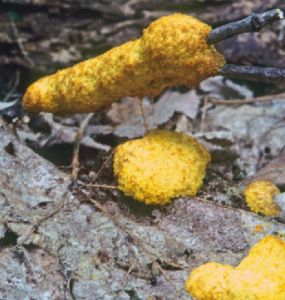Fuligo septica

Image Courtesy of Peter Katsaros
| Click to Enlarge |
| Click For Image Gallery |
|
Group of Fungi: Slime Molds Family: Physaraceae Latin Name: Fuligo septica (L.) F.H. Wigg. Common Name: Scrambled Egg Slime Description: Cushion-shaped to irregular structure, 1 5/8–10 in (4–25 cm) wide and 3/8–1 1/4 in (1–3 cm) thick, at first soft and slimy but becoming dry and brittle, yellow to orange when fresh but fading to pale tan on the outside, black on the inside; stalk lacking; spore-bearing surface lacking; spores black in mass. Biological Role: The vegetative stage (called a plasmodium) in the life cycle of this organism feeds upon the bacteria associated with decaying plant material. Habitat: On decaying wood or litter in broadleaf or conifer forests; also occurring on wood chips and mulch beds in landscaped areas. Geographical Distribution: Found throughout the world. Comments: The slime molds are not true fungi but are found in many of the same situations. Fuligo septica is one of the largest of all slime molds and is often quite conspicuous because of its size and color. Although it might not appear to be edible, the developing fruiting bodies of Fuligo septica have been consumed by humans. |
| Go Back |